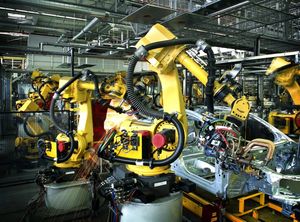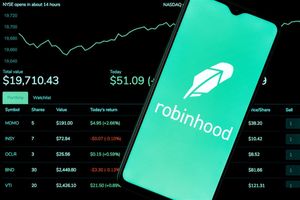
In a move that has sent ripples through both the automotive and tech sectors, Tesla (NASDAQ: TSLA) CEO Elon Musk has made a monumental declaration: the company's humanoid robot, Optimus, is projected to eventually constitute a staggering 80% of Tesla's overall value. This bold assertion signals a profound strategic reorientation for the electric vehicle giant, positioning it as a burgeoning powerhouse in artificial intelligence (AI) and robotics rather than solely an automotive manufacturer. The announcement, coupled with aggressive production targets aiming for thousands of Optimus units by 2025 and a significant ramp-up by 2027, underscores a pivotal moment that could redefine Tesla's identity and its trajectory in the global market.
Musk's pronouncement comes as Tesla navigates increasing competition and maturing markets in its core EV business. The ambitious vision for Optimus, therefore, represents a crucial new growth narrative, promising to unlock unprecedented revenue streams and revolutionize various industries by providing a scalable solution for labor-intensive tasks. Investors have largely responded positively, with Tesla's stock experiencing a notable surge, yet skepticism persists regarding the feasibility of such an accelerated timeline and the operational capabilities of the nascent robotics division.
Optimus Takes Center Stage: Tesla's Bold New Direction
Elon Musk's pronouncement that Optimus will eventually represent "80% of Tesla's value" came primarily through a post on X (formerly Twitter) in September 2025. This declaration isn't just a casual remark; it frames Tesla's (NASDAQ: TSLA) future valuation far beyond its current automotive manufacturing prowess, signaling a complete embrace of AI, autonomy, and robotics as the company's central pillars. Musk envisions Optimus generating upwards of $10 trillion in revenue, fundamentally reshaping labor-intensive industries by deploying humanoid robots across diverse environments to boost productivity. This ambitious plan aligns with Tesla's "Master Plan Part IV," which places Optimus at the forefront of achieving a "sustainable and prosperous" society driven by large-scale AI robotics.
The journey for Optimus began with its initial introduction in 2021, followed by the unveiling of prototypes in 2022. While initial targets aimed for Optimus to be "production-ready" by 2023 and integrated into Tesla factories by late 2024, the revised, yet still aggressive, timeline outlines a critical path for accelerated production. Tesla expects Optimus to enter "low production" for internal use within its own factories in 2025, with a goal of having "thousands" of Optimus robots working alongside human employees by the end of that year. Specifically, plans are in motion to build 1,000 to 2,000 units of the Optimus V3, a "pre-commercial" model deemed stable enough for pilot deployment, supported by a dedicated section of Gigafactory Texas and an expanded robotics team.
Looking further ahead, Tesla is targeting high-volume production for external commercial availability in 2026, with an aim to scale production capacity to between 50,000 and 100,000 units annually. By 2027, the company projects an annual output of approximately 500,000 units, with Musk expressing confidence in reaching a staggering 1 million units per year within the next five years, around 2030. These ambitious targets, however, face acknowledged challenges, primarily the absence of an existing supply chain for specialized components like motors, gearboxes, and actuators, which Tesla may have to develop largely in-house.
The market's reaction has been largely one of cautious optimism, intertwined with a degree of skepticism. Musk's bold predictions provide a much-needed "different growth story" for Tesla, whose core EV business has experienced slowing sales and heightened competition recently. Following the mass production announcement, Tesla's stock price reportedly soared by over 20% in just five trading days, indicating significant investor belief in Musk's ability to actualize this futuristic vision. Analysts like Morgan Stanley have highlighted the potential for Optimus to drastically reduce Tesla's workforce by up to 10%, translating into substantial savings, and project the broader humanoid robot market could exceed $5 trillion. However, critics point to Musk's history of overly optimistic timelines for projects like Full Self-Driving (FSD) and Robotaxis, raising concerns about potential delays and the actual operational autonomy of early Optimus models.
A New Playing Field: Winners and Losers in the Robotic Era
Elon Musk's audacious pivot towards humanoid robotics with Optimus has the potential to redraw the competitive landscape across multiple industries, creating distinct winners and losers. At the forefront of the winning column is, undoubtedly, Tesla (NASDAQ: TSLA) itself. Should Optimus achieve even a fraction of Musk's projected success, Tesla would transform from a leading EV manufacturer into a dominant AI and robotics powerhouse. This diversification offers a potent new revenue stream, potentially shielding the company from the inherent cyclicality and intensifying competition within the automotive sector. The ability to leverage Optimus for internal manufacturing could also significantly reduce operational costs, creating a competitive advantage that extends beyond product innovation to process optimization.
Beyond Tesla, a constellation of companies involved in advanced component manufacturing for robotics stands to gain significantly. While Tesla aims for increased vertical integration, many specialized components will still be externally sourced. Firms like Nvidia (NASDAQ: NVDA), a leader in AI chips and computational platforms, could see increased demand for their advanced GPUs as Tesla scales its AI training for Optimus. Companies specializing in high-precision actuators and motors, such as Sanhua Intelligent Control (SZSE: 002050) and Tuopu Group (SSE: 601689) for actuator assemblies and harmonic reducers, respectively, are poised for growth. Similarly, manufacturers of miniature 6-axis force/torque sensors (e.g., Resense, ATI Industrial Automation) and advanced pressure sensors (e.g., Hanwei Technology (SZSE: 300007)) will be in high demand, crucial for Optimus's environmental awareness. Battery suppliers like CATL (SZSE: 300750) and providers of lightweight materials such as carbon fiber (Zhongfu Condor) are also identified as potential beneficiaries.
Industries facing labor shortages, high labor costs, or requiring repetitive and dangerous tasks are prime candidates for adopting Optimus and other humanoid robots, leading to increased productivity and efficiency. Manufacturing is expected to be a primary adopter, with companies like Mercedes-Benz (FSE: MBG) and Jabil (NYSE: JBL) exploring humanoid robot applications in their facilities for tasks like assembly and machine operation. Logistics and warehousing, with companies such as Amazon (NASDAQ: AMZN) already testing humanoid robots like Agility Robotics' Digit, could see streamlined operations in material transport and inventory control. Healthcare, retail, and even agriculture also represent significant potential adoption sectors, allowing human staff to focus on more complex tasks.
On the other side of the ledger, established companies and workforces reliant on traditional labor models, particularly for repetitive or dangerous tasks, could face significant disruption. Industries heavily dependent on manual human labor for blue-collar or semi-skilled roles, such as aspects of manufacturing and logistics, may experience job displacement as robots fill roles and optimize workforces. Some studies suggest a substantial portion of jobs could be at risk of automation in the coming decade, necessitating significant retraining and upskilling initiatives for human workers. Furthermore, competitors in the humanoid robotics market, particularly those with less scalable operations or lacking Tesla's vertical integration and robust AI capabilities derived from its Full Self-Driving efforts, may struggle to keep pace. While pioneers like Boston Dynamics (owned by Hyundai Motor Company) have demonstrated impressive agility with robots like Atlas, their current high costs and niche applications might struggle against a mass-produced, more affordable Optimus.
A New Industrial Revolution: Broader Implications and Industry Shifts
Elon Musk's audacious vision for Optimus transcends merely creating a new product; it hints at the precipice of a new industrial revolution, with profound implications for global industries, labor markets, and even societal structures. This event fits squarely into broader industry trends emphasizing advanced automation, artificial intelligence (AI) integration, and the increasing convergence of physical and digital worlds. As industries worldwide grapple with labor shortages, rising wages, and the pursuit of greater efficiency, the prospect of versatile, dexterous humanoid robots capable of performing a multitude of tasks offers a compelling solution that could accelerate the shift towards fully autonomous operations in manufacturing, logistics, healthcare, and even domestic settings. The ambitious production targets of 5,000 units by 2025 and an eventual goal of 100 million units annually underscore Optimus's potential for mass accessibility and widespread adoption, aiming to unlock multi-trillion-dollar market opportunities.
The ripple effects of Optimus's potential success could be immense, impacting both competitors and partners. For existing industrial automation companies and other robotics firms, Tesla's (NASDAQ: TSLA) entry with a mass-produced, potentially affordable humanoid robot could represent both a significant threat and an opportunity. Direct competitors in the humanoid robotics space, such as Boston Dynamics (Atlas), Figure AI (Figure 02), Unitree (G1), Apptronik (Apollo), and AgiBot, will face intense pressure to innovate and compete on cost, dexterity, and agility, especially given Tesla's target price point around $20,000. Other automotive manufacturers will also be compelled to accelerate their own AI and autonomous development as Tesla redefines the scope of an "automotive company." Conversely, component suppliers in AI hardware, advanced sensors, and robotic components may find new opportunities, though those solely focused on traditional automotive offerings might face risks.
Beyond the immediate industry, the regulatory and policy implications are substantial. The widespread deployment of humanoid robots like Optimus raises critical questions about labor displacement, ethical considerations of AI, data privacy, and safety standards. Governments and regulatory bodies, such as the National Highway Traffic Safety Administration (NHTSA) in the U.S. and various EU agencies, will need to develop new frameworks to ensure the safety of autonomous robots operating in environments with humans, establish liability for potential accidents, and address concerns around data privacy and ethical AI use. Policies will also be needed to mitigate potential income inequality and support workforce retraining, given projections that up to 800 million jobs worldwide could be affected by automation by 2030, particularly in manufacturing and transportation. The sheer scale of Tesla's ambition could necessitate entirely new regulatory categories, akin to the early days of aviation or the internet.
The introduction of Tesla Optimus draws significant parallels to historical technological disruptions that fundamentally reshaped industries and societies. Similar to the Industrial Revolution, where mechanization led to job displacement (e.g., the Luddite Rebellion) but ultimately spurred new industries and increased productivity, Optimus signifies a new wave of automation. It represents an evolution from the first industrial robot, UNIMATE, deployed in a General Motors (NYSE: GM) assembly line in 1961, which marked the dawn of factory automation, to a general-purpose humanoid capable of much broader applications. Like the advent of the personal computer or AI as a general-purpose technology, Optimus has the potential for widespread transformative impact, leading to both job disruption and the emergence of new, more productive opportunities, posing complex challenges for policymakers and society to navigate.
The Road Ahead: Navigating a Robotic Future
The path forward for Tesla (NASDAQ: TSLA) and its Optimus humanoid robot is fraught with both immense opportunity and formidable challenges, promising to define the company's trajectory for decades to come. In the short term, the primary focus will be on the successful internal deployment of Optimus within Tesla's own factories, aiming to have thousands of units performing repetitive and dangerous tasks on assembly lines by 2025. This internal validation is crucial for refining the technology, gathering operational data, enhancing efficiency, and building confidence among potential external customers. Pilot programs in controlled industrial settings, such as manufacturing and logistics, are also anticipated to refine the technology and gather valuable operational data, although initial production has lagged behind ambitious targets, with fewer than 500 units reportedly produced as of mid-2025.
Looking further out, the long-term possibilities for Optimus are truly transformative. Tesla anticipates mass production and widespread deployment across various sectors, including logistics, healthcare, and domestic services. This vision aims to create an entirely new economy centered on general-purpose humanoid robots, addressing labor shortages and boosting productivity globally. Musk projects that Optimus could eventually account for a staggering 80% of Tesla's valuation, unlocking a multi-trillion-dollar market opportunity, potentially generating $10 trillion in revenue. This strategic pivot involves an "AI-First Approach," leveraging Tesla's Full Self-Driving (FSD) expertise, a "vision-only" training system, and deep investments in hardware and infrastructure, potentially integrating Optimus synergistically with FSD and Robotaxi networks.
Emerging market opportunities are vast, with the humanoid robot market projected to grow significantly. Optimus could drive massive productivity gains, creating new revenue streams through direct sales, leases, software subscriptions for AI upgrades, and maintenance services. However, formidable challenges persist, including significant technical hurdles, particularly in refining dexterity, endurance, and addressing mechanical complexities and overheating issues in the robot's hands and lower arms. Production delays and the intense competition from other robotics companies like Boston Dynamics and Figure AI (Figure 02) also pose substantial challenges. Public perception regarding job displacement and the need for evolving regulatory frameworks for safety, ethics, and data privacy will also demand careful navigation as Tesla aims for a mass-production cost target of $20,000-$30,000 per unit.
Potential scenarios range from an optimistic outcome where Optimus rapidly achieves mass adoption and dominance, significantly contributing to Tesla's market cap and revolutionizing global labor markets, to a more realistic scenario of moderate, phased growth due to persistent technical and scaling challenges. A pessimistic scenario could see Optimus remaining a niche product, struggling with high costs, intense competition, and regulatory hurdles, failing to deliver on the projected valuation impact. The outcomes will hinge on Tesla's execution, its ability to overcome complex engineering and production challenges, and its success in convincing a skeptical world that the future of labor is indeed humanoid.
The Dawn of a Robotic Era: A Concluding Perspective
Elon Musk's assertion that Optimus will eventually account for 80% of Tesla's (NASDAQ: TSLA) value marks one of the most significant strategic declarations in the company's history, signaling a profound reorientation from an electric vehicle leader to a dominant force in artificial intelligence and robotics. The key takeaway from this event is Tesla's unwavering commitment to diversifying its core business, seeking a new, potentially exponential, growth vector as its EV market matures. The success of Optimus hinges on Tesla's ability to transition from prototypes to scalable, reliable, and cost-effective mass production while navigating complex technical, competitive, and regulatory landscapes.
Moving forward, the market's perception of Tesla will increasingly be intertwined with the tangible progress of Optimus. While initial investor enthusiasm has been evident, with a notable surge in Tesla's stock post-announcement, sustained belief will require concrete demonstrations of Optimus's capabilities and its economic viability. The success of internal deployments within Tesla's own factories will serve as critical benchmarks, validating the robot's operational readiness and ability to deliver on the promises of efficiency and cost reduction. The narrative around Tesla is no longer solely about cars and batteries; it is now heavily invested in the realization of a science fiction vision where autonomous humanoid robots revolutionize human endeavor.
The lasting impact of this endeavor could be monumental. If Tesla succeeds, Optimus could fundamentally alter manufacturing processes, alleviate labor shortages across multiple sectors, and reshape global economies. This would not only secure Tesla's position at the forefront of technological innovation but also catalyze a broader industrial revolution, prompting other companies to accelerate their investments in advanced robotics. What investors should closely watch in the coming months are the quarterly updates on Optimus's internal deployment, any new technical demonstrations showcasing enhanced capabilities, and further details regarding its production ramp-up and cost structure. Tesla's ability to execute on its ambitious AI and robotics vision, rather than just vehicle sales, will be the primary determinant of its valuation moving forward. Investors should also monitor regulatory developments, the competitive landscape, and Tesla's overall financial performance, especially as it continues to invest heavily in AI and robotics amidst fluctuating EV demand.





